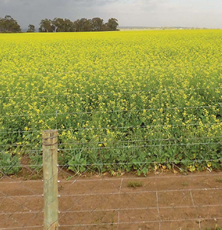Maize Farming
Topography of the Land and Its Impact On Maize Crops
 The topography, or physical features of the land, encompasses its contours, slopes, and overall structure. Maize crops, sensitive to their environment, respond dynamically to these features. Understanding the lay of the land is crucial to the planting and growth of maize.
The topography, or physical features of the land, encompasses its contours, slopes, and overall structure. Maize crops, sensitive to their environment, respond dynamically to these features. Understanding the lay of the land is crucial to the planting and growth of maize.
Crucial aspects of topography in maize crops
Water Drainage Dynamics: One of the paramount considerations in topography is its influence on water drainage. The slope of the land dictates how water moves across the field. For maize ensuring proper drainage is essential. Waterlogged conditions can compromise root health and overall plant vigour. Through contouring and strategic planning, farmers can mitigate drainage challenges.
Read more ...
Carbon Sequestration in Africa at the Expense of Livelihoods and biodiversity
By Dr Arne Witt, CABI Africa
 According to the World Resources Centre, Africa accounts for only 2–3 percent of the world’s carbon dioxide emissions from energy and industrial sources. In fact, Africa’s per capita emissions of carbon dioxide in the year 2000 were 0.8 metric tons per person, compared with a global figure of 3.9 tons per person.
According to the World Resources Centre, Africa accounts for only 2–3 percent of the world’s carbon dioxide emissions from energy and industrial sources. In fact, Africa’s per capita emissions of carbon dioxide in the year 2000 were 0.8 metric tons per person, compared with a global figure of 3.9 tons per person.
However, climate change will have a disproportionate impact on the world’s poorest countries, most of them in Africa. In order to mitigate against climate change, some donors have developed, and in some cases already initiated, massive ‘greening’ programs across much of the continent, largely to sequester carbon dioxide produced by the donor countries themselves.
In some cases, these may benefit African nations by improving land productivity and biodiversity conservation. However, in many cases development agencies advocate the planting of exotic species, many of which are known to be invasive, in large monocultures across what many development actors perceive to be unproductive land or wastelands.
Read more ...
Magical Canola
 The striking colourful flowers resembling a rolled out yellow carpet create a rare spectacle on a farm. This exotic plant which can grow up to four feet with a maturity period of between 75 and 90 days can easily be mistaken for an overgrown kale plant. Though not relatively new in Kenya, canola crop is fast gaining popularity among farmers, both large and small scale. Majority of those who have embraced the crop are doing so for purposes of selling the seeds for production of cooking oil. The by-product is a much sought commodity by dairy farmers. What remains after the oil has been extracted from the canola seeds is fodder rich in proteins. Its scarcity in the country has seen dairy farmers import the product from Tanzania to supplement the protein diet for their cows.
The striking colourful flowers resembling a rolled out yellow carpet create a rare spectacle on a farm. This exotic plant which can grow up to four feet with a maturity period of between 75 and 90 days can easily be mistaken for an overgrown kale plant. Though not relatively new in Kenya, canola crop is fast gaining popularity among farmers, both large and small scale. Majority of those who have embraced the crop are doing so for purposes of selling the seeds for production of cooking oil. The by-product is a much sought commodity by dairy farmers. What remains after the oil has been extracted from the canola seeds is fodder rich in proteins. Its scarcity in the country has seen dairy farmers import the product from Tanzania to supplement the protein diet for their cows.
But while many of the growers are aware of the benefits of this crop which traces its origin to Canada, few of the farmers are yet to fully appreciate its weed and disease controlling capability especially on cereal crops. Growing canola as a rotational crop could resort to a farmer saying goodbye to disease such as fusarium and pythium which are known to cause heavy losses in barley and wheat. Experts now say using canola as a rotational crop reduces close to 100 percent of all post-harvest losses associated with cereal crop diseases. They suggest that a lot of the root diseases affecting wheat and barley can easily be avoided especially if farmers moved away from mono-cropping.
Read more ...
Here are Farming Rules
By David Ndegwa
 Farming is like a game and to play any game effectively, one must acquaint himself/herself with its rules. A chess player who wins the game usually has the same number of subjects as his opponent but what makes him win is how he moves them.
Farming is like a game and to play any game effectively, one must acquaint himself/herself with its rules. A chess player who wins the game usually has the same number of subjects as his opponent but what makes him win is how he moves them.
In farming, all farmers use the same tools but the difference comes in how each tool is used. Success or failure in farming, therefore, comes as a result of efficiency on the use of the tools but not on luck or timing. In farming, there are two major key components that define success or failure.
– Things that a farmer can control
– Things that a farmer can’t control.
To succeed, a farmer needs to identify what is under his/her control and take charge of that on a 100% basis. What is in the farmer control?
Read more ...
 The topography, or physical features of the land, encompasses its contours, slopes, and overall structure. Maize crops, sensitive to their environment, respond dynamically to these features. Understanding the lay of the land is crucial to the planting and growth of maize.
The topography, or physical features of the land, encompasses its contours, slopes, and overall structure. Maize crops, sensitive to their environment, respond dynamically to these features. Understanding the lay of the land is crucial to the planting and growth of maize. According to the World Resources Centre, Africa accounts for only 2–3 percent of the world’s carbon dioxide emissions from energy and industrial sources. In fact, Africa’s per capita emissions of carbon dioxide in the year 2000 were 0.8 metric tons per person, compared with a global figure of 3.9 tons per person.
According to the World Resources Centre, Africa accounts for only 2–3 percent of the world’s carbon dioxide emissions from energy and industrial sources. In fact, Africa’s per capita emissions of carbon dioxide in the year 2000 were 0.8 metric tons per person, compared with a global figure of 3.9 tons per person. The striking colourful flowers resembling a rolled out yellow carpet create a rare spectacle on a farm. This exotic plant which can grow up to four feet with a maturity period of between 75 and 90 days can easily be mistaken for an overgrown kale plant. Though not relatively new in Kenya, canola crop is fast gaining popularity among farmers, both large and small scale. Majority of those who have embraced the crop are doing so for purposes of selling the seeds for production of cooking oil. The by-product is a much sought commodity by dairy farmers. What remains after the oil has been extracted from the canola seeds is fodder rich in proteins. Its scarcity in the country has seen dairy farmers import the product from Tanzania to supplement the protein diet for their cows.
The striking colourful flowers resembling a rolled out yellow carpet create a rare spectacle on a farm. This exotic plant which can grow up to four feet with a maturity period of between 75 and 90 days can easily be mistaken for an overgrown kale plant. Though not relatively new in Kenya, canola crop is fast gaining popularity among farmers, both large and small scale. Majority of those who have embraced the crop are doing so for purposes of selling the seeds for production of cooking oil. The by-product is a much sought commodity by dairy farmers. What remains after the oil has been extracted from the canola seeds is fodder rich in proteins. Its scarcity in the country has seen dairy farmers import the product from Tanzania to supplement the protein diet for their cows. Farming is like a game and to play any game effectively, one must acquaint himself/herself with its rules. A chess player who wins the game usually has the same number of subjects as his opponent but what makes him win is how he moves them.
Farming is like a game and to play any game effectively, one must acquaint himself/herself with its rules. A chess player who wins the game usually has the same number of subjects as his opponent but what makes him win is how he moves them.